When it goes about the quality car music, the first thing to do is install the best 6×9 speakers. Their performance usually differs greatly from the regular stock speakers, while the price isn’t high.
The market offers plenty of alternatives varying in design, build and sound quality, mounting options, etc. Here’s a shortlist of parameters to consider when purchasing the speakers for your car:
- Drivers. The basic models represent a single driver transmitting the whole frequency range. Still, there are models having more drivers (even 4-driver ones, with super-tweeter) and ensuring better handling of extreme frequencies. Still, the differentiation of drivers usually means higher power requirements and the need for a good crossover.
- Power and amplifier requirements. The additional car speaker systems usually require little power. However, the better the driver build, sensitivity, and output, the more power is required. Some speakers even require an external amplifier to produce all the juice they possess. At the same time, hooking up an amplifier means more twiddling with the installation and additional costs involved.
- Mounting method. While all models are of the same size, they differ in the actual construction and method of mounting. Some can have propping or too recessed grills, others feature the holes that don’t match with the car design, etc. Consider the mounting method and tools required before buying the particular speaker model.
Check the versatile high-quality offers among the reviews below.
Make your car sound perfect!
6×9 Speakers Reviews
Infinity REF9620CX
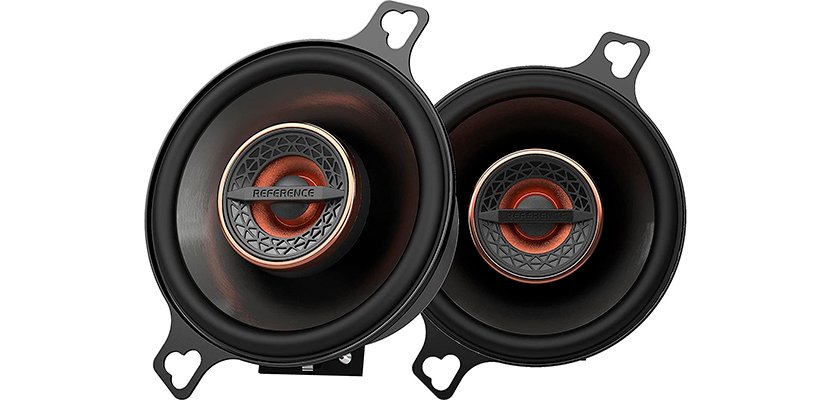
If the clean and powerful sound is what you’re aiming at, and you are ready to spend a bit more than average, this acoustic set will definitely be the one to consider. High sensitivity, small impedance, and precise, clear highs would let them be called the best 6×9 component speakers. However, the mount bracket isn’t all-fit type and might require even some modification to be performed for particular car models.
The speaker implements two drivers of high build quality. The textile woofers efficiently reproduce the lows and mids without resonance or another distortion. They’re equipped with long and thin voice coils ensuring the clarity and precision of the sound. Mids are rich and confident, with even response throughout the range. The bass comes solid and rocky, while the sub-bass frequencies are a bit blurred and sometimes might seem inexpressive. This accounts for the frequency range starting with 46Hz.
Still, the separate tweeter lets enjoy the transparent and exact highs up to 21 kHz, with accurate voice-and-instrument picturing. Overall, the sound is clean and powerful, with the soundstage featuring good depth and precise imaging.
The speakers’ sensitivity makes 93 dB, which means they handle the high volume well not losing the extreme frequencies and keeping the performance clear. The impedance makes 3 Ohms enabling them to work with the majority of car systems and produce high-quality sound. Meanwhile, the max power capacity of the Infinity 6×9 speakers makes 125W RMS; so, the external amplifier connected would greatly enhance the performance. The additional power brings more punch and improves overall dynamics.
Pros
- High breaking strength provides solid performance in various road conditions.
- Beats are accurate and punchy throughout the volume range.
- Natural sound, with warm uppers mids and highs.
Cons
- Highs can be overwhelming with the amp connected.
- Require a sub to produce a full sub-bass range.
Kicker D-Series
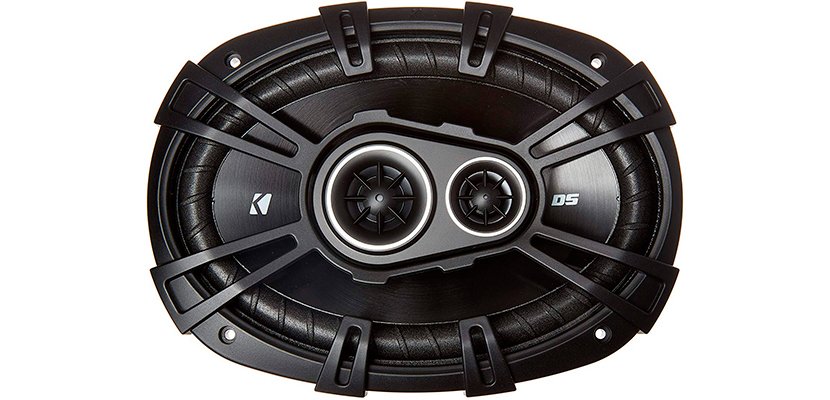
Decent clean sound, three-way design, and high compatibility make the highlights of this acoustic set, while the low price lets them win a place among the best 6×9 car speakers with many drivers. Still, the bottom-low end can be uneven and muddy, due to the limited frequency range.
Each speaker consists of the woofer, tweeter, and super-tweeter justifying the solid audio on high and super-high frequencies. The woofer is made of polypropylene and has good rigidity. It produces clear mids and hard bass with good depth and dynamics. The frequency range starts with 30Hz and ends at 20 kHz, while the response throughout the range is mostly even, with small gaps in the low bass line. The accuracy is high, the instruments and voices are distinctive and reproduced naturally, without digital aftertaste or reverberation. Mids are sharply drawn and represent a lot of depth and detail. Highs are even and precise, not overly bright but very clear and accurate.
The soundstage isn’t too wide; yet, the imaging is quite good, and the bass isn’t overloading. The sound flows dynamically, with good attack and overall balance.
The Kicker 6×9 set features high sensitivity letting get a clean and powerful sound at high volume. The RMS makes 70W and the impedance is 4 Ohms serving for high compatibility with the majority of car head units. With the amplifier connected, the lows become smoother and deeper, while the mids and highs acquire yet fuller representation.
Pros
- Low profile with almost zero tweeter protrusion ensure a good fit with many car models.
- Great for listening to vocals, with clear and confident output.
- Modern sleek design.
Cons
- Bass rolls off at the very high volume.
- Mounting holes are a bit closer than on the most stock speakers.
Pioneer TS-A6970F
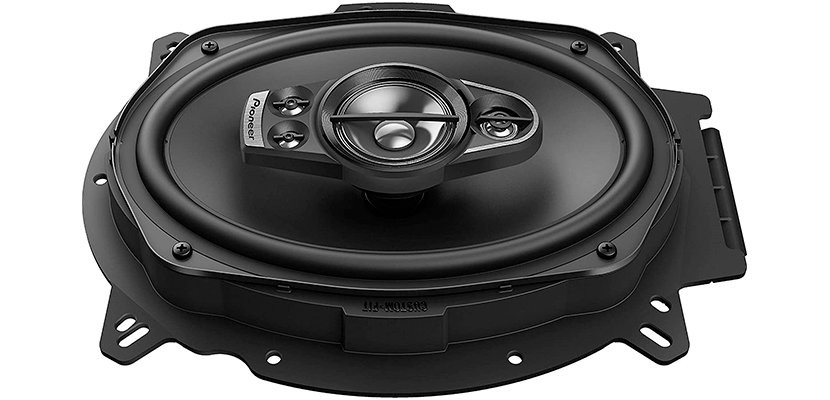
Five-driver design at the price of the single-driver device, with well-known Pioneer sound of smooth and dynamic performance, — it’s about the Pioneer TS-A6970F. The solid base cone brings the “window-rattling” effect and solid lows putting these ones into the “best 6×9 speakers for bass” category. Still, the sub-bass isn’t too deep but rather wide and boomy.
Two tweeters and a super-tweeter make the upper mids and highs transparent, glass clean and powerful. Each tune is heard distinctly and the slightest variations are pictured precisely. The frequency response is smooth and balanced, with the upper limit reaching 25 kHz.
The mids and lows are produced through the IMPP cone, with a steady response until the 30-34Hz. There’s no muddiness in the sub-bass end, either. However, the sound lacks density and depth fully present in the low mids and bass frequencies. Overall, the bass is enveloping and confident, with a distinctive middle line.
They have a standard impedance of 4 Ohms letting them pair easily with the most car head units and audio systems. The peak power for these Pioneer 6×9 speakers makes 600W, which leads to the enhanced sound clarity and dynamics with the additional power source. The amplifier connected, the attack becomes more expressive and the lower end gains more base. The crossover works seamlessly ensuring balanced output with high clarity. There’s also little coloration to the sound, with the incline to the warmer performance.
Pros
- Distortion-free performance throughout the volume range (up to 90 dB).
- The polymer surround keeps the audio free from vibration in different road conditions.
- Good heat dissipation, don’t get warm easily.
Cons
- Sized 9 x 7 x 3 inches, they mightn’t fit some of the car openings for speakers.
- Short cables, make a bother to install.
Jl Audio C2-690tx
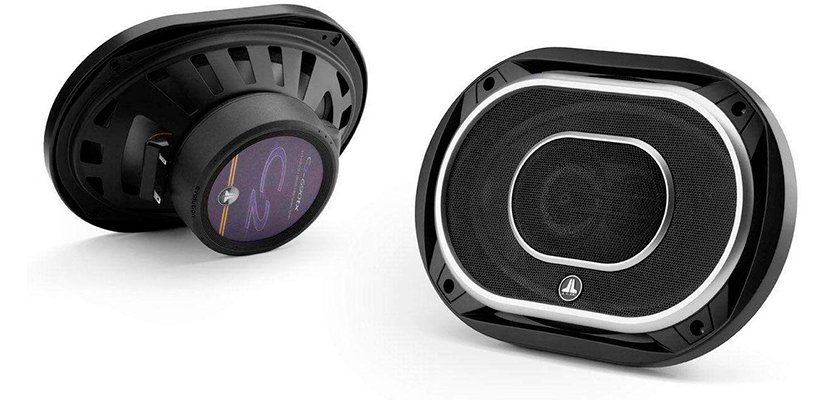
High-quality driver build and vast power range let the Jl Audio 6×9 set deliver the crisp and punchy sound comparable to full-size speakers’ performance. The speaker features the three-way design including the midbass driver, the midrange one, and the silk-dome tweeter, being efficient and steady at all types of frequencies.
The woofer is large having 6 x 9 inches. Its mineral-enhanced polypropylene structure brings composed and wide bass, accurate and powerful. The mids are handled by the 2-inch driver ensuring smooth response, with precise picturing and good depth. The tweeter emits airy exact highs featuring high clarity up to extreme 22 kHz frequencies. The lower frequency limit makes 53Hz, while the sub-low end is also reproduced decently.
The speakers create the wide rich soundstage with accurate positioning. Each sound comes accurate and colorless, true-to-source. The standard impedance on these ones is backed up by the considerable power range starting from 15W and reaching 125W. The speakers sound yet wider and deep with the amplifier hooked up while working well with standard head units. This model could certainly be placed among the best 6×9 speakers for cars unless its huge size (11.7 x 6.5 x 15.4 inches) wouldn’t make installation a pain in some cars with thin doors or a lot of stuff inside the door.
Pros
- The strong dynamic sound throughout the frequency range.
- 93 dB sensitivity lets the window rattle without losing in audio quality.
- The magnet has rubber protection and doesn’t scratch at the installation.
Cons
- At the extreme higher end, the sound becomes harsh.
- The fixed tweeter doesn’t provide much flexibility for soundstaging.
Pioneer TS-A6996S
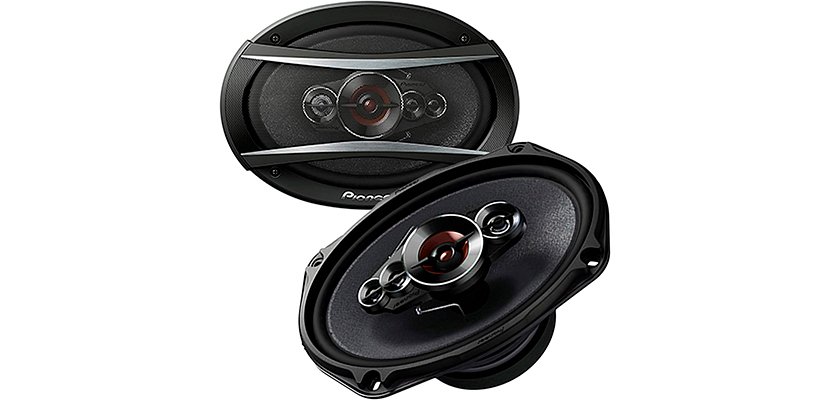
Small but powerful, these 650-Watt 6×9 speakers can really blow away with the loud yet crisp and detailed audio. With the five drivers made of high-quality materials, they can satisfy the needs of drivers of the wide range of vehicles from private cars to touristic buses.
For that, the speakers are made smaller than the average 6×9 sets (9 x 7 x 3 inches) and are very lightweight (no more than 1 pound per speaker). That lets them fit into the various shapes and sizes of car speaker slots, with the installation being easy and fast.
Each speaker consists of the large Mica-enforced woofer with multilayer structure reproducing bass frequencies, good size (1 ⅝-inch) midrange with the paper cone, a ¾-inch tweeter (made of PET material), and two 3/8-inch super-tweeters (PET). The woofer is surrounded by an elastic polymer, which is able to damp considerable vibration and keep the distortion away. Together, the drivers provide a balanced and clear output and highly dynamic sound with a good amount of attack.
The bass in these 6×9 speakers is distinctive and enveloping, with clear low-to-mid tonality and thumpy midbass. There might be a slight roll-off at bottom-low frequencies (beneath declared 28Hz); however, it doesn’t affect most “bass bound” styles like hip-hop, alt-rock, etc. Though it’s not the speaker for “bass heads”, the low-end performance is confident and immersive, with high clarity preserved.
Pros
- Wide and airy high, with precise picturing up to 38 kHz frequency.
- Deep and well-drawn soundstage with rich detail.
- Loud and accurate.
Cons
- Sound fidelity and sensitivity might be insufficient without the amp.
- Mounting screws are small and mightn’t ensure a solid fixation in the particular setup.
Video Pioneer TS-A6996S
JBL Club 9630
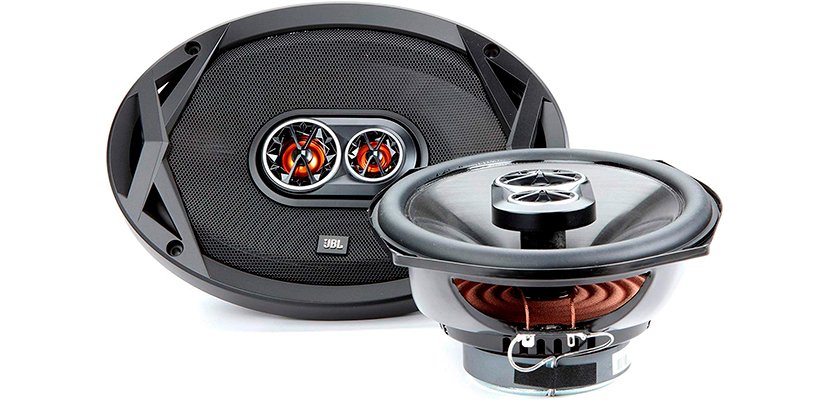
Cheap 6×9 speakers, with the three-way system, high sensitivity, and small impedance — all that’s about JBL 9630 model. If you’re aiming at good sound for non-audiophile listening and don’t crave for heavy bass but appreciate clarity and detail, these speakers are certainly the ones to consider.
These 6×9 component speakers have a big 6×9 woofer, which is made of polypropylene and handles mids and lows, a polyamide tweeter and super-tweeter handling frequencies up to 20 kHz. The lower limit makes 50Hz. In general, lows are decent, with even response throughout the range and good dynamics. The bass isn’t too deep; yet, it feels confident and precise. Mids are clear, with all the lines being distinctive and featuring a considerable amount of detail. Upper frequencies are handled well up until the prescribed limit, above which they tend to get thinner and shriller.
The speaker has 3-Ohm impedance and can work with most head units and older car stereos without issues. Adding an amp, though, doesn’t change the performance much, while adding a bit of depth to the mids and upper mids. The max power output makes 240W, which, paired with the 93 dB sensitivity, provides good volume and minimal distortion even when the speaker is cranked up.
The Club 9630 6×9 speakers aren’t the smallest or lightest on the list; still, the speaker base features the adaptor ends letting fit into the various car models.
Pros
- Implemented Plus One technology of woofer membrane fixation increases the woofer surface and the richness and clarity of the audio output.
- Original design with brass tweeter cones and textured diffraction rings.
- Included spacer ring lets decrease the speaker depth.
Cons
- The soundstage isn’t too wide.
- Sub-bass becomes unsteady at high volume.
Infinity PR9613IS
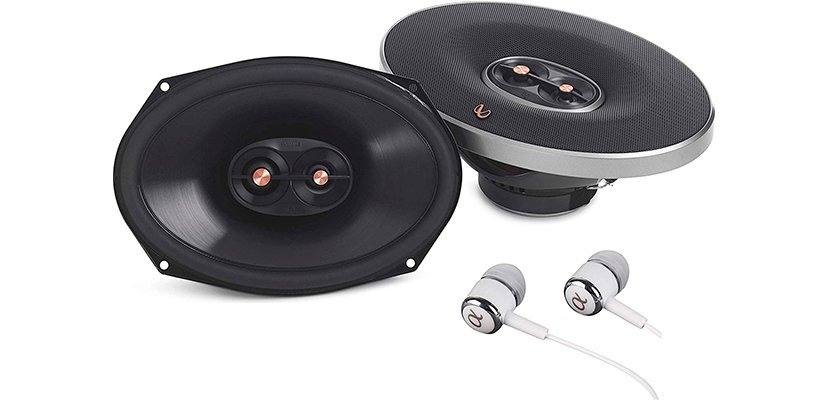
When looking into the Infinity Primus series of 6×9 car speakers, they show a set of features aimed at various situations. They have low impedance, good wattage, and middle size fitting various car speaker spaces, and are highly versatile. Still, their distinctive feature is the high fidelity and cleanness of the signal, which is free from any vibration or resonance. The speakers deliver a wide soundstage with rich detail and exact imaging.
They are three-way coaxial ones, with large Plus One woofer and silk-dome tweeters. Crossovers aren’t large but work seamlessly creating the balanced and dynamic output. The sound flows easily and features good precision. The mids are clear and detailed but not bright. The transition from mids to highs is graduate, without abrupt changes or clips. The highs seem a bit thin at the limit of 28 kHz; yet, provide a lot of detail and clarity. Voices and upper instrumental tunes are solid and don’t get blurred or mixed.
The woofer starts “picking” the quality distortion-free sound from 40Hz, while the lows come steady and deep enough — the bass is thumpy and springy, with a solid attack. Still, the depth depends highly on the speaker’s position and the surrounding space.
The Infinity Primus 6×9 speakers implement the “true 4-Ohm” technology having the nominal impedance at 3 Ohms, while the working one makes about 4 Ohms. This lets pair them with practically any car head unit and get decent sound without amplification.
Pros
- Rubber woofer surround keeps the lows and mids even and clear.
- Ventilation openings at the magnet prevent overheating.
- Various fixation adaptor rings included.
Cons
- No mounting screws supplied.
- Deep at 5 inches, the speakers might interfere with the window in some car models.
Rockford Fosgate P1692
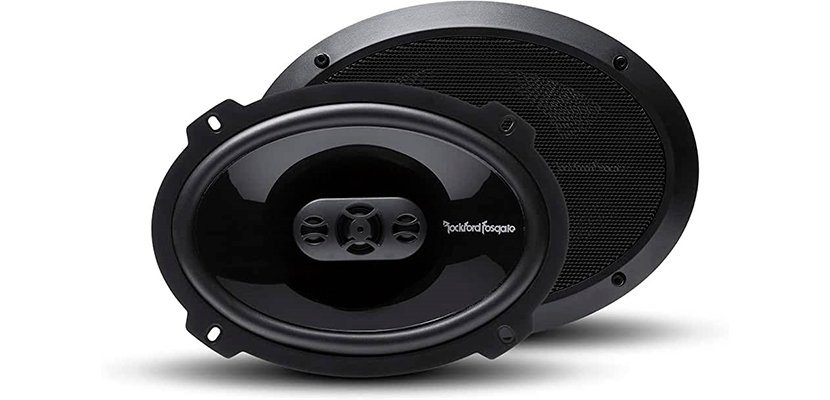
“Sturdy and efficient” are the first words coming to mind when talking about Rockford Fosgate car acoustics. The speakers described here match the rule as they feel rock solid and deliver quality audio comparable to much more expensive models.
The two-way construction provides for a woofer and tweeter reproducing the full standard frequency spectrum. The woofer is made of polypropylene and is installed following the patented VAST technology allowing for the larger cone surface. The case has the butyl rubber filling supporting the cone and ensuring its complete rigidity and clear frequency response.
Mid frequencies are vast and solid, with even gapless response and high accuracy. There’s no mistaking the instruments or misinterpreting vocals even in the noisy car environment. Meanwhile, the bass in this Rockford Fosgate 6×9 set doesn’t lack strength or dynamics, as in many speaker models of the same price range. It is expansive and has good depth while preserving high clarity of the output starting at the announced 60Hz.
The PEI tweeter is situated in the center of the woofer and manages highs quite well within the declared 22 kHz limit. The tonality is even and the sound is rich, while towards the extreme frequencies the audio might tend to scream.
The speakers feature the true 91 dB sensitivity and can play loud without noticeable changes to the sound output. The 4-Ohm impedance lets pair them with almost any car stereo system, while the external amplifier boosts the lower end and brings yet more confidence to the middle line.
Pros
- Airy deep enough soundstage with a lot of detail.
- Crossover is built-in and hidden within the basket (no installation issues).
- The basket features slots in place of mounting holes, for higher flexibility during installation.
Cons
- Rather low power output (75W per speaker).
- Due to large size (17.5 x 12 x 5 inches), it might require additional spacers and tools for installation.
JBL GTO939 Premium
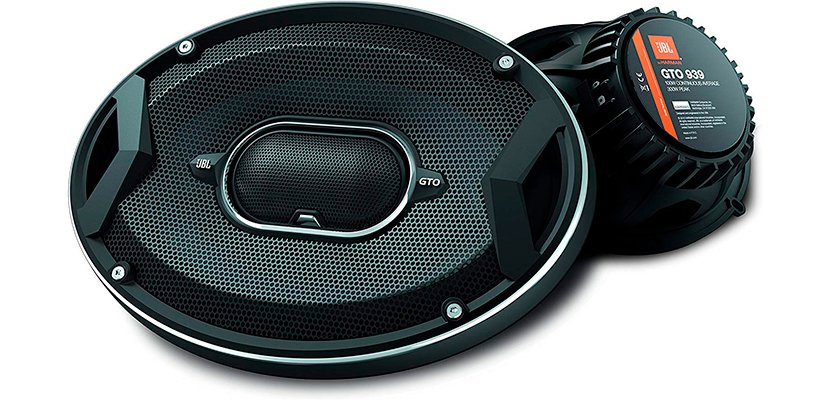
This model is a solid pair of two-way car speakers that deliver hi-fi sound with rich low end and crisp highs and provide for additional tuning opportunities. That being said, the price doesn’t exceed the average level for upper-budget car acoustic sets making this product a great value for money.
The coaxial speakers have a large woofer and a tweeter supported by the solid crossover. The latter works seamlessly distributing the frequencies and resulting in the smooth frequency response throughout the declared 46 – 21,000 Hz.
The woofer has the carbonized cone featuring large surface thanks to Plus One technology implemented. This lets it manage more air and add solidity to the lows and mids. Overall, the bass produced by the JBL 6×9 Premium set feels dense and precise, with a strong attack and no rolls off up until the bottom-low tunes. It complements the detailed and confident mids, which might be a fraction bright to the audiophile ear but provide a precise melodic pattern.
The 1-inch tweeter is made of Mylar-Titanium material ensuring the complete rigidity, fast sound dispersion, and increased power of the output. The highs delivered are crystal clear and free from harshness, while not being overly bright or artificially rounded.
The speakers have 3-Ohm impedance and don’t overload the car system either bring thin sound due to thin wiring or not too powerful head unit. Meanwhile, adding an amp brings additional dynamics and punch into the performance.
Pros
- UniPivot mechanism lets control the tweeter position at any time creating the optimal sound dispersion.
- Good power handling and high sensitivity result in high audio clarity throughout the volume range.
- Fast and trouble-free installation in place of any OEM car speaker set.
Cons
- Considerable depth (5.9 inches) might become an issue during installation in non-OEM cars.
- No mounting screws / additional brackets supplied.
Infinity Kappa 693
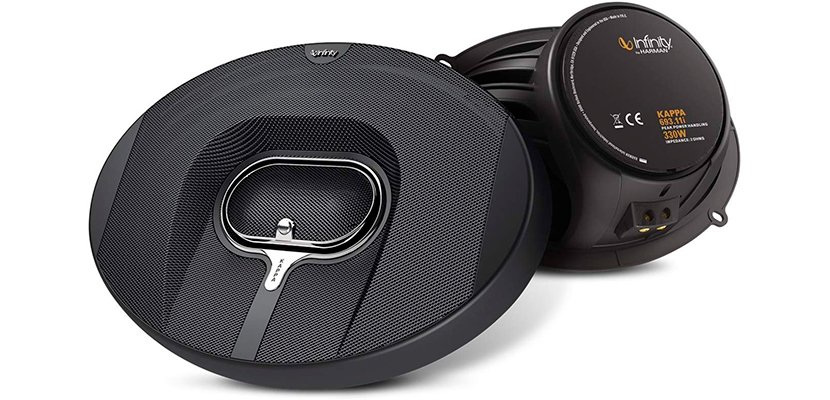
If you’re picky about the quality of sound and need something more than just good 6×9 speakers but don’t want to spend a fortune on car acoustics, the Infinity Kappa should definitely be mentioned on your checklist. These speakers look and sound great, while their price is just slightly above the average for the upper-budget models.
The sound is reproduced through three high-quality drivers and features a solid frequency response within the 35Hz – 30 kHz. The output is clean, without interference or clipping, and creates the effect of the concert hall when listening.
The woofer is made of Glass Fiber injected with carbon and ensuring stable shape and next to the minimal distortion. It’s installed by the Plus One technology and has a large surface resulting in the punchy deep rocking bass and decent mids.
The tweeter and the super-tweeter have soft fabric dome and provide a steady output within upper mids and highs. The solid build and efficient power handling (330W at peak and 110 RMS per unit) let the sound stay clear and rich up to the extreme 30,000Hz, with accurate picturing of vocals and instruments.
The speakers have one of the lowest impedance rates providing for the high compatibility with the factory car systems and head units and not requiring the replacement of the thin car wiring. Meanwhile, the sensitivity of these units reaches 96 dB ensuring the clarity of all frequencies at a different volume.
Pros
- High dynamics throughout the frequency range.
- High woofer cone stiffness lets install the speakers in the hollow car spaces, without noticeable losses in sound quality.
- Unique stepped design, with expensive-looking chromium inserts.
Cons
- Bulky (16.3 x 6.5 x 11.3 inches), mightn’t be a good fit for many cars.
- The midrange is slightly recessed in comparison to boosted lows and highs.
JBL GTO939
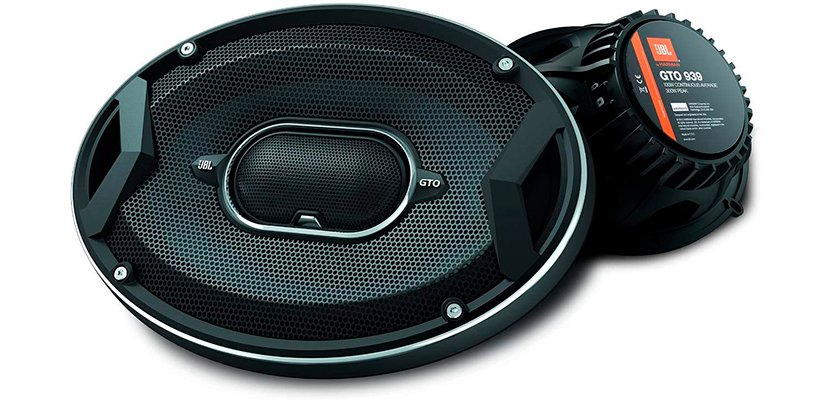
Full clear sound comparable to the home acoustic systems makes this 6×9 speaker stand out among other car acoustic sets. Priced slightly above the average market offers, the JBL GTO939 speakers deliver the immersive and detailed sound that can be played on extreme volume without quality losses.
Comprising of a woofer, tweeter, and super-tweeter, these speakers emit the true-to-source clean audio without coloration and with the distinctive middle line. The woofer has low Q-factor providing the transparent yet solid bass, which, though, isn’t going too low (starting to fall out at declared 45 – 50Hz lower frequency limit).
The tweeter and super-tweeter are composed of Mylar-Titanium and deliver very crisp and steady highs, without shrieking or waning out even at 21,000Hz (upper-frequency limit). The tweeters are pivotable, which helps amend the sound dispersion and overall effect upon the installation and create more open or narrower soundstage.
The speakers have low 2-Ohm impedance providing high flexibility for the audio source types. Even the weak stock car radio sounds decent and has good depth. Meanwhile, the nominal RMS power makes 100W per unit serving for additional dynamics boost and higher clarity audio with the amplifier connected.
Pros
- Climate- and wear-proof design, works well in the heat and cold.
- Particularly clear highs backed up by the oversized voice coil.
- Incorporated crossover features high-quality pass filters for optimal frequency distribution.
Cons
- The mounting holes don’t provide the universal fit.
- Somewhat uneven response at low-to-mid spectrum.
Buyer’s Guide
What Makes Speakers Sound Well?
When listening to different models of speakers, one might notice there’s a difference in their output. While the sound quality estimation is rather subjective, there are basic parameters widely acknowledged as “good sound”. Grouped together, they are based on sound fidelity or authenticity.
Frequency response
The first parameter to consider is the “working” range or the speaker or its frequency response. This rate shows the spectrum of frequencies the speaker can reproduce faithfully, with high fidelity to the source. Usually, the frequency range provided by the speakers’ manufacturer falls within the spectrum audible by the human ear (16Hz – 20 kHz). The frequencies exceeding these limits aren’t audible; yet, the clear reproduction of 22 kHz or 14Hz frequencies will result in more balanced sound transmission, with more detail, transparency, and dynamics.
The frequency range can be separated into sub-ranges having their own designation. The sub-bass frequencies reign on 20 – 60Hz, the bass goes at 60 – 250Hz, lower mids start with 250Hz and end up somewhere near 500Hz, the midrange falls within 500Hz – 2 kHz spectrum, upper mids reach 4KHz, and all of the above is usually marked as “highs”.
The majority of modern speakers provides a wide range of frequencies handled. However, their output differs considerably. The range alone doesn’t stand for the good sound, but the character of the response matters as well. Usually, the more enhanced speakers’ models provide more even response pattern and “catch” the vast frequency range. However, one model can surpass another at some level of frequencies (e.g. lows or mids). This advantage is both discerned by the ear and can be seen on the frequency chart. The flatter, closer to the central line is the signal, the more accurate the frequency response is.
Driver cones materials
Driver cones in speakers serve to push the sound wave and disperse it. While the task seems simple, differently composed cones don’t do it in the same way.
The cone material defines how rigid the cone is, how fast it pushes the sound, and how much distortion is added to the wave. Distortion could be caused both by cone vibration and external factors.
The more the cone’s surface deforms, the more distortion it adds to the sound. However, the hard metal or steel brings the metallic echo and aftertaste, which is unfavorable for the sound. Another reservation concerns the cone movement. It moves back and forth to push the wave; so, it should be lightweight enough to be pushed by the small electric impulse. So, today manufacturers test various materials and composites attempting to find the balance between cone rigidity and natural sound. At the same time, it should be taken into account that particular frequencies are handled better by more or less rigid materials. The most popular cone materials are the following:
- Polypropylene has good rigidity and uniformity but less dynamic than paper analogs. Another big advantage of the PET cones is their low cost.
- Paper delivers a punchy attack and high dynamics, as well as precise solid highs. Expensive to produce and are subject to humidity.
- Fabric or wool is lightweight and soft, while distortion could be higher than with rigid cones.
- Metal (aluminum, titanium, etc.) is rigid but expensive and heavy.
Sound designs
The sound design stands for the number of features determining the way the speaker is engineered and how it works. Here are the most important elements of sound design:
- Drivers number and location. The speaker might feature a single driver to reproduce the full range of frequencies or split them between separate drivers. Besides, the drivers can be represented by separate units or make the body of one speaker (coaxial models). The number of drivers doesn’t directly influence the sound quality. Their material, smoothness of frequency response matter as well. The most frequent multiple-driver design consists of a woofer, tweeters, and super-tweeters. Still, even granted the driver’s quality is high, it should be hooked up correctly, with the right frequencies coming to it.
- Crossover. That’s an appliance regulating the frequencies distribution. It splits the outgoing sound signal into different frequency bands and sends them to the relevant drivers in a speaker. The crossover can be passive (drawing power from the source) or active (with an amp). The crossover accuracy and overall performance depend on the power output and impedance.
- Surrounding material and enclosure. The speaker’s body and surrounding material should fit tight and ensure minimal vibration to the drivers. The polymer foam, various kinds of rubber can be used as the surrounding material. The enclosure should have an optimal shape and be made of the material with good dampness (preferably wood) to submerge the vibration produced by the speaker’s work.

Hi everyone! I’m Thomas Moody, also known as Guitarzan.
